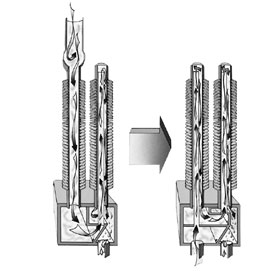

For air-heating coils, steam is the preferred medium for heat transfer throughout much of industry. Steam is easy and inexpensive to move from the boiler to the point of use, and it gives up much of its energy at a constant temperature when it condenses. Process control is easy and fast with steam, and there is essentially no lag time.
Making decisions about coil construction and materials is a multi-step process involving many factors. Armstrong’s line of heavy-duty steam coils is designed and manufactured to provide what you want most—long life and efficient heat transfer.
For air-heating
coils, steam is the preferred medium for heat transfer throughout much
of industry. Steam is easy and inexpensive to move from the boiler to
the point of use, and it gives up much of its energy at a constant
temperature when it condenses. Process control is easy and fast with
steam, and there is essentially no lag time.
Making decisions about coil construction and materials is a
multi-step process involving many factors. Armstrong’s line of
heavy-duty steam coils is designed and manufactured to provide what you
want most—long life and efficient heat transfer.
Standard coils (Type S)
This type of coil is used
for most applications where entering air temperatures are above 35°F
(2°C) and steam is at constant pressure. It is used extensively in
high-temperature process applications and for “reheat” in HVAC systems.
It is not, however, recommended where even outlet air temperatures are
required immediately after the coil, such as in multi-zone heating
systems or where a modulating steam control valve is used to control
temperature. (See drawing.)
Centifeed coils (Type C)
The single-row centifeed
coil can be used where air is below freezing and/or modulating control
is used. It is recommended where:
Two-row centifeed coils are available where (B) and (C) are required,
but tandem-type coils are a better choice with freezing air
temperatures.
A centifeed coil is one plain tube—called the inner steam
distribution tube—inserted in an outer finned tube. The center tube is
fed with steam, which travels up this and is then discharged into the
outer tube. It then travels back between the outside wall of the
distribution tube and the inside wall of the finned tube to the
condensate header. The inner tube acts as a steam tracer to keep the
finned tube warm along its total length. (See drawing.)
Tandem coils (Types T and P)
Freezing
applications requiring more than one row to achieve the desired final
air temperature demand this type of a coil. The coil is designed so that
the total amount of steam to be condensed by the whole coil is fed into
the first row in the direction of airflow. This purges non-condensable
gases and droplets of condensate from that part of the coil exposed to
the coldest air. Channeling the steam from the header to the other rows
in the series has the same purging effect. This design ensures that air
passing over the last row is at least 35°F (2°C).
The coldest part of the coil will always have steam in sufficient
quantity to overcome unequal distribution and “backfeeding” due to
differing steam loads and pressure drops in adjacent tubes. This
eliminates freezing problems caused by condensate holdup.
The “series” feed characteristic of the tandem coil, as opposed to
the “parallel” feed of the two-row centifeed coil, makes it the ideal
choice for multi-row coils in freezing applications. If you want a
stainless steel tube tandem, specify a P type. (See drawings.)
For help in specifying the exact model you need, download the product literature.
No PDF available for download.
No PDF available for download.
No PDF available for download.
No PDF available for download.
Copyright © 2025 Campbell-Sevey, Inc.